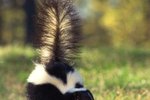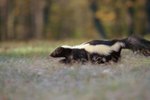
Despite their mild disposition and unique aesthetic, skunks are among the most reviled mammals in the country. These North American natives aren't ferocious, but their foul spray creates an unmistakable pungent odor that lingers for days. Skunks tend to migrate frequently and hide in a variety of den sites.
Gypsy Squatters
Aside from their powerful spray, skunks rely on temporary dens to protect themselves when they aren't out foraging. If you happen to notice a skunk residing in a den, there's a good chance he'll be gone in a matter of days. They are active foragers, so they move from site to site to find new sources of food. Skunks adopt den sites that are within two miles of fresh water and they rarely travel more than a mile or two from their current den to forage, according to Florida State University Habitat Tracker. A pregnant female may reside in a secure nest for several months while she rears her young.
In the Wild
While skunks thrive in urbanized areas, they are wild animals and are adapted for natural environments. They prefer forested areas with plenty of brush and other places to hide. Skunks are equipped with powerful claws that allow them to dig their own dens in the dirt, but they prefer to squat in the abandoned nests of ground squirrels, marmots and other creatures, according to Washington Department of Fish and Wildlife. They also make their homes in secure places like crevices in rocks, interiors of hollow logs and holes in tree trunks.
Skunk and Civilization
Despite their wild nature, skunks readily shack up in man-made structures regardless of nearby activity. They may spend a few days hiding under your porch and they have no problems repurposing any kind of dark enclosure around your property. They may even enter your home through an open air vent or broken basement window. Culverts and other outdoor drains are appealing hiding places for skunks, so approach such openings with care if you live in an area populated by skunks, according to Maine Department of Inland Fisheries and Wildlife. Garages, barns and other structures separate from the home are also likely sites for a skunk den.
Seek and Discourage
While some homeowners allow skunks to leave on their own, households with pets or small children may forcefully eject the animal to ensure the safety of the family. Sprinkle flour around entrances to potential hiding spots and check for signs of paw prints the next day to identify active den sites, according to City of Sacramento Department of General Services. Place a loud radio near the den site and leave it on through the night. Just make sure you don't disturb the neighbors too. You can spray the area with animal repellent to sour the den site. Consider contacting animal control to address the problem if you can't remove the skunk on your own.
Skunk Appeal
Taking a few basic steps to discourage skunks from hiding on your property is usually enough to keep the pesky creatures out. These measures also encourage local skunks to evacuate expediently. Plug up all skunk-sized holes, including openings beneath wood and rock piles. Make sure there are no open entrances into your home. Skunks can climb up trees and can access your attic, so don't forget to check up there too. Don't leave cat or dog food outside overnight and keep garbage in sealed containers. Skunks prey on smaller creatures occasionally, but free foraged food is their primary diet.
References
Photo Credits
-
Tom Brakefield/Stockbyte/Getty Images
Writer Bio
Quentin Coleman has written for various publications, including All Pet News and Safe to Work Australia. He spent more tan 10 years nursing kittens, treating sick animals and domesticating semi-feral cats for a local animal shelter. He graduated from the University of Delaware with a bachelor's degree in journalism.




